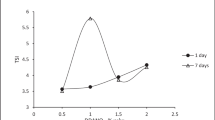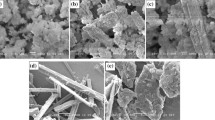Abstract
The possibility of using organomineral complexes of polyhexamethylene guanidine hydrochloride as a functional additive for a waterborne paint based on polyvinyl acetate has been investigated. Organomineral complexes containing 20 and 30 wt % guanidine polymer have been obtained, with intercalation of polyguanidine chains into the interlayer space of montmorillonite being observed. It has been revealed that the stability of the polymer film to water is retained when organomineral complexes are introduced into a polyvinyl acetate dispersion, whereas the water resistance of the film sharply decreases when free polyguanidine is added. There was no significant influence of organomineral complexes on the rheological characteristics of the dispersion and its sedimentation stability. Testing of waterborne paints with various additives has shown that introduction of organomineral complexes into the material prevents the coating from fouling by biofilms of gram-positive bacteria Staphylococcus aureus and Rhodococcus erythropolis, with the hardness, water resistance, and water-vapor transmission of the coatings being retained at a satisfactory level.





Similar content being viewed by others
Notes
3-(4,5-Dimethyl-2-thiazolyl)-2,5-diphenyl-2H-tetrazolium bromide. This compound is metabolized by microbial cells to form a colored compound (formazan); the appearance of a corresponding purple color indicates the presence of metabolically active bacterial cells in the sample.
REFERENCES
D. Nichols, Biocides in Plastics (iSmithers Rapra Publishing, 2005).
N. D’Arcy, Plast. Add. Comp. 3, 12 (2001).
A. Jones, Plast. Add. Comp. 11, 26 (2009).
S. P. Tambe, S. D. Jagtap, A. K. Chaurasiya, and K. K. Joshi, Prog. Org. Coat. 94, 49 (2016).
U. Makal, L. Wood, D. E. Ohman, and K. J. Wynne, Biomaterials 27, 1316 (2006).
L. Giacomucci, N. Raddadi, M. Soccio, N. Lotti, and F. Fava, New Biotechnol. 52, 35 (2019).
I. G. Kalinina, K. Z. Gumargalieva, and S. A. Semenov, Prot. Met. Phys. Chem. Surf. 54, 1330 (2018).
N. B. Halima, RSC Adv. 6, 39823 (2016).
M. V. Zhurina, A. Y. Kallistova, A. E. Panyushkina, A. V. Gannesen, S. V. Mart’yanov, V. A. Gerasin, N. A. Sivov, V. A. Tikhomirov, and V. K. Plakunov, Microbiology 89, 396 (2020).
O. Bondarenko, K. Juganson, A. Ivask, K. Kasemets, M. Mortimer, and A. Kahru, Arch. Toxicol. 87, 1181 (2013).
M. K. Oule, R. Azinwi, A. M. Bernier, T. Kablan, A. M. Maupertuis, S. Mauler, R. K. Nevry, K. Dembélé, L. Forbes, and L. Diop, J. Med. Microbiol. 57 (12), 1523 (2008).
D. U. Park, J. Park, K. W. Yang, J. H. Park, J. H. Kwon, and H. B. Oh, Molecules 25, 3301 (2020).
V. A. Gerasin, D. I. Mendeleev, V. V. Kurenkov, and M. R. Menyashev, Russ. J. Appl. Chem. 91, 1297 (2018).
R. D. Holtz, B. A. Lima, A. G. Souza Filho, M. Brocchi, and O. L. Alves, Nanomed. Nanotechnol. Biol. Med. 8, 935 (2012).
M. Amann and O. Minge, “Biodegradability of poly(vinyl acetate) and related polymers,” in Synthetic Biodegradable Polymers (Springer, 2011), pp. 137–172.
H. H. Murray, Appl. Clay Sci. 17, 207 (2000).
S. Sas, M. Danko, V. Bizovská, K. Lang, and J. Bujdák, Appl. Clay Sci. 138, 25 (2017).
V. A. Gerasin, V. V. Kurenkov, O. V. Pashkov, and S. O. Ilyin, Colloid J. 79, 588 (2017).
V. V. Kurenkov, O. V. Pashkov, and V. A. Gerasin, Izv. Vyssh. Uchebn. Zaved., Ser. Khim. Khim. Tekhnol. 62, 126 (2019).
V. K. Plakunov, S. V. Mart’yanov, N. A. Teteneva, and M. V. Zhurina, Microbiology 85, 509 (2016).
Y. Assem, A. I. Khalaf, A. M. Rabia, A. A. Yehia, and T. A. Zidan, Polym. Bull. 74, 3015 (2017).
G. Choudalakis and A. D. Gotsis, Eur. Polym. J. 45 (4), 967 (2009).
R. F. Langendonk, D. R. Neill, and J. L. Fothergill, Front. Cel. Infect. Microbiol. 11, 665759 (2021).
O. Ciofu and T. Tolker-Nielsen, Front. Microbiol. 10, 913 (2019).
S. Hemati, E. Kouhsari, N. Sadeghifard, A. Maleki, N. Omidi, Z. Mahdavi, and I. Pakzad, New Microb. New Infect. 38, 100794 (2020).
ACKNOWLEDGMENTS
The studies were carried out using instruments of the Shared-Use Center at the Topchiev Institute of Petrochemical Synthesis.
Funding
The work was carried out within the framework of the State Assignment of the Institute of Petrochemical Synthesis of the Russian Academy of Sciences, state reg. no. AAAA-A19-119020490054-7, and the State Assignment of the Federal Research Center for Biotechnology of the Russian Academy of Sciences, state reg. no. 122040800164-6.
Author information
Authors and Affiliations
Corresponding author
Ethics declarations
The authors declare no conflict of interest.
Additional information
Translated by S. Zatonsky
Publisher’s Note.
Pleiades Publishing remains neutral with regard to jurisdictional claims in published maps and institutional affiliations.
Rights and permissions
About this article
Cite this article
Gerasin, V.A., Zhurina, M.V., Kurenkov, V.V. et al. Prospects for Application of Guanidine-Containing Organomineral Complexes as Biocidal Functional Additives for Waterborne Polymer Materials. Polym. Sci. Ser. B 65, 681–691 (2023). https://doi.org/10.1134/S1560090423701269
Received:
Revised:
Accepted:
Published:
Issue Date:
DOI: https://doi.org/10.1134/S1560090423701269




